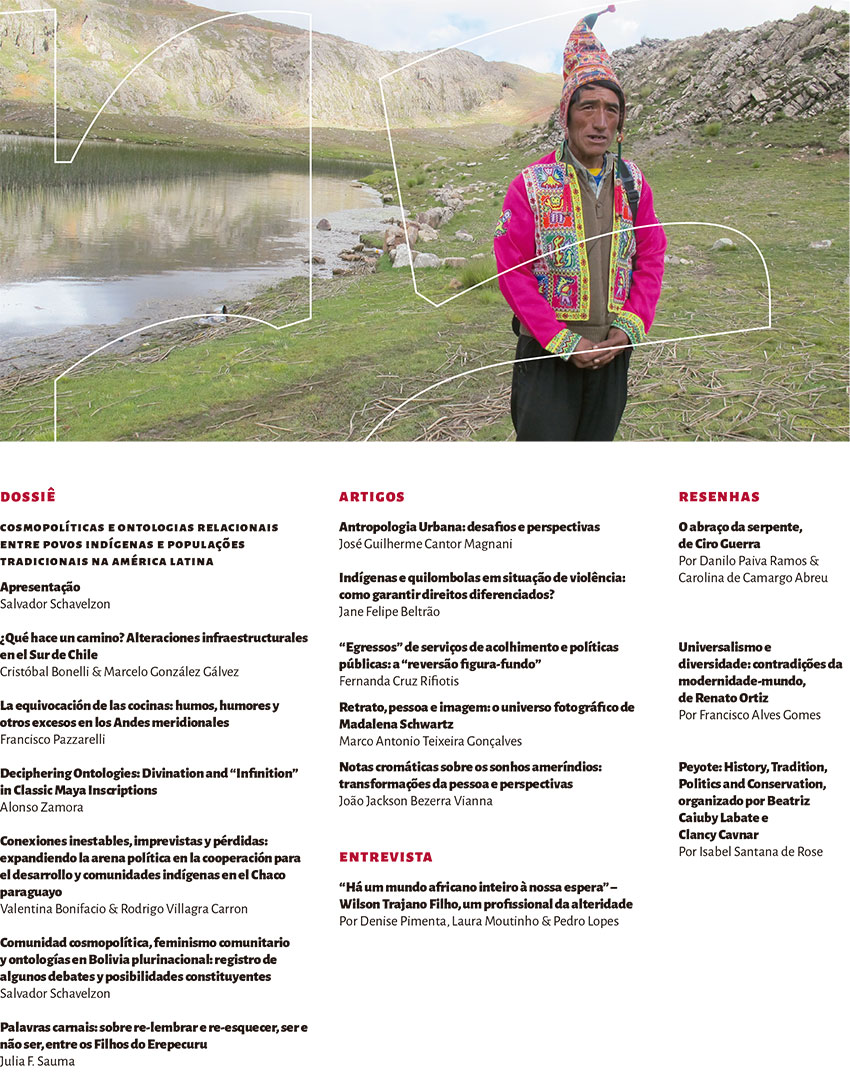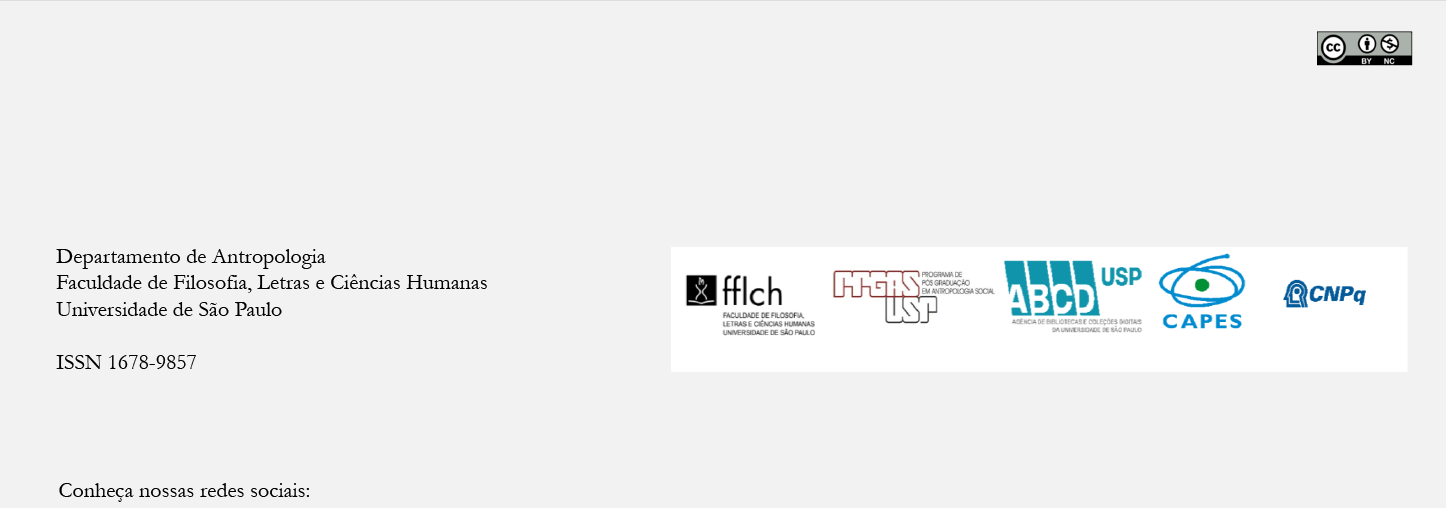¿Qué hace un camino? Alteraciones infraestructurales en el Sur de Chile
DOI:
https://doi.org/10.11606/2179-0892.ra.2016.124804Palavras-chave:
camino, infraestrutura, Mapuche, mente inmanente, alteración ontológicaResumo
En este artículo, intentamos dar cuenta de la transformación sociomaterial que ha gatillado la construcción de caminos en los mundos indígenas del sur de Chile. Inspirados inicialmente por la noción de “mente inmanente” batesoniana, intentamos comprender y conceptualizar las capacidades de los caminos para potenciar radicalmente la reconstitución de un mundo relacionalmente constituido, y que por tanto es de suyo contingente. A partir de nuestras exploraciones etnográficas, proponemos que el camino no posibilita la alteración simplemente porque promueve el contacto, la interconexión, y las relaciones interculturales, sino porque altera materialmente el mundo, promoviendo relaciones intersociomateriales determinadas infraestructuralmente. Finalmente, exponemos que la alteración material del mundo produce resultados inciertos, posibilitando incluso su propia destrucción. En este sentido, este trabajo discute etnográficamente el problema de la auto-determinación ontológica en términos infraestructurales.
Downloads
Referências
ALLERTON, Catherine. 2013. Potent Landscapes: Place and Mobility in Eastern Indonesia. Honolulu, University of Hawaii Press.
ANCÁN, José y CALFÍO, Margarita. 1999. “Retorno al país mapuche. Reflexiones en torno a una utopía por construir”. Liwen, n. 5: 43-77.
AUGUSTA, Félix José. 2007 [1916]. Diccionario araucano. Santiago, Ediciones Cerro Manquehue.
AYLWIN, José; YAÑEZ, Nancy y SÁNCHEZ, Rubén. 2013. Pueblo mapuche y recursos forestales en Chile: devastación y conservación en un contexto de globalización económica. Observatorio Ciudadano, Iwgia.
BASHKOW, Ira. 2004. “A Neo-Boasian Conception of Cultural Boundaries”. American Anthropologist, vol. 106, n. 3: 443-458.
BATESON, Gregory. 1972. Steps to an Ecology of Mind. London, Jason Aronson Inc.
BENGOA, José. 2000 [1985]. Historia del pueblo mapuche: siglo xix y xx. Santiago, Lom. BENNETT, Jane. 2010. Vibrant Matter: A Political Ecology of Things. Durham, Duke University Press.
BOCCARA, Guillaume. 2007. Los vencedores: historia del pueblo mapuche en la época colonial. San Pedro de Atacama, Santiago, Línea Editorial iiam - Universidad Católica del Norte, Universidad de Chile.
BONELLI, Cristóbal. 2012. “Ontological Disorders: Nightmares, Psychotropic Drugs and Evil Spirits in Southern Chile”. Anthropological Theory, vol. 12, n. 4: 407-426.
BONELLI, Cristóbal. 2014. “What Pehuenche Blood Does: Hemic Feasting, Intersubjective Participation, and Witchcraft in Southern Chile”. Hau: Journal of Ethnographic Theory, vol. 4, n. 1: 105-127.
BONELLI, Cristóbal. 2015. “Eating One’s Worlds: On Foods, Metabolic Writing and Ethnographic Humour”. Subjectivity, vol. 8, n. 3: 181-200.
BONELLI, Cristóbal y VICHERAT MATTAR, Daniela En prensa “Towards a Sociology of Equivocal Connections”. Sociology. CORREA, Martín y MELLA, Eduardo. 2010. Las razones del illkun/enojo: memoria, despojo y criminalización en el territorio mapuche de Malleco. Santiago, Lom.
COURSE, Magnus. 2011. Becoming Mapuche: Person and Ritual in Indigenous Chile. Urbana, University of Illinois Press.
COURSE, Magnus. 2012. “The Birth of the Word: Language, Force, and Mapuche Ritual Authority”. Hau: Journal of Ethnographic Theory, vol. 2, n. 1: 1-26.
COURSE, Magnus. 2014. “The End of Me: The Role of Destiny in Mapuche Narratives of the Person”. In oakdale, S. y course, m. (orgs.), Fluent Selves: Autobiography, Person and History in Lowland South America. Linconl, University of Nebraska Press, pp. 144-162.
DALAKOGLOU, Dimitris y HARVEY, Penny. 2012. “Roads and Anthropology: Ethnographic Perspectivas on Space, Time and (Im)mobility”. Mobilities, vol. 7, n. 4: 459-465.
DE LA CADENA, Marisol. 2010. “Indigenous Cosmopolitics in the Andes: Conceptual Reflections beyond ‘Politics’”. Cultural Anthropology, vol. 25, n. 4: 334–70.
DELEUZE, Gilles y GUATTARI, Félix. 1987. A Thousand Plateaus. Minneapolis, University of Minnesota Press.
DI GIMINIANI, Piergiorgio. 2013. “The Contested Rewe: Sacred Sites, Misunderstandings and Ontological Pluralism in Mapuche Land Negotiations”. Journal of the Royal Anthropological Institute, vol. 19, n. 3: 527-544.
DI GIMINIANI, Piergiorgio. 2015. “The Becoming of Ancestral Land: Place and Property in Mapuche Land Claims”. American Ethnologist, vol. 42, n. 3: 490-503.
FARON, Louis. 1961. “The Dakota-Omaha Continuum in Mapuche Society”. Journal of the Royal Anthropological Institute, vol. 91, n. 1: 11-22.
FERNÁNDEZ, César (org.). 1999. Cuentan los mapuches. Buenos Aires, Editorial Nuevo Siglo.
FOERSTER, Rolf. 2004. ¿Pactos de sumisión o actos de rebelión? Una aproximación histórica y antropológica a los mapuches de la costa de Arauco, Chile. Leiden, tese, Universiteit Leiden.
FOERSTER, Rolf y MENARD, André. 2009. “Futatrokikelu: Don y autoridad en la relación mapuche-wingka”. Atenea, n. 499: 33-59.
GONZÁLEZ, Héctor. 1986. “Propiedad comunitaria o individual. Las tierras indígenas y el pueblo mapuche”. Nütram, vol. 2, n. 3: 7-13.
GONZÁLEZ GÁLVEZ, Marcelo. 2015. “The Truth of Experience and Its Communication: Reflections on Mapuche Epistemology”. Anthropological Theory, vol. 15, n. 2: 141-157.
GONZÁLEZ GÁLVEZ, Marcelo. 2016. Los mapuche y sus otros: persona, alteridad y sociedad en el sur de Chile. Santiago, Editorial Universitaria.
GÜNDERMANN, Hans; CANIHUAN, Jacqueline; CASTILLO, Ernesto y CLAVERÍA, Alejandro. 2008. Perfil sociolingüístico de comunidades mapuches de la viii, ix y x Región. Santiago, Universidad Tecnológica Metropolitana.
HENARE, Amiria; HOLBRAAD, Martin y WASTELL, Sari. 2007. Thinking through Things: Theorising Artifacts Ethnographically. London, Routledge.
HENNION, Antoine y GRENIER, Line. 2000. “Sociology of Art: New Stakes in a Post-Critical Time”. In Quah, S. R. y sales, a. (orgs.), The International Handbook of Sociology. London, Sage, pp. 341-355.
HOLBRAAD, Martin; PEDERSEN, Morten y VIVEIROS DE CASTRO, Eduardo. 2014. “The Politics of Ontology: Anthropological Positions”. Theorizing the contemporary, Cultural Anthropology website, January 13, 2014. https://culanth.org/fieldsights/462-the-politics-of-ontology-anthropological-positions.
JENSEN, Casper Brunn. 2015. “Experimenting with Political Materials: Environmental Infraestructuras and Ontological Transformations”. Distinktion: Scandinavian Journal of Social Theory. 1-14. 2016. “Pipe Dreams: Sewage Infrastructures and Activity Trails in Phnom Penh”. Ethnos 1-21.
KOESSLER-ILG, Berta. 2007. Cuenta el pueblo mapuche. Santiago, Mare Nostrum.
KOHN, Eduardo. 2013. How Forest Think: Toward an Anthropology beyond the Human. Berkeley, University of California Press.
LARKIN, Brian. 2013. “The Politics and Poetics of Infrastructure”. Annual. Review of Anthropology, vol. 42: 327-343.
LATOUR, Bruno. 1988. “The Politics of Explanation: An Alternative”. In WOOLGAR, S. (org.), Knowledge and Reflexivity. London, Sage, pp. 155-177.
LEA, Tess y PHOLEROS, Paul. 2010. “This is not a Pipe: The Treacheries of Indigenous Housing”. Public Culture, vol. 22, n. 1: 187-209.
LÉVI-STRAUSS, Claude. 1943. “The Social Use of Kinship Terms among Brazilian Indians”. American Anthropologist, vol. 45, n. 3: 398-409.
MATURANA, Humberto y VARELA, Francisco. 1984. El árbol del conocimiento: las bases biológicas del entendimiento humano. Santiago, Editorial Universitaria.
MEINERT, Lotte y KAPFERER, Bruce. 2015. In the Event: Toward an Anthropology of Generic Moments. London, Berghahn.
MILLALÉN, José. 2006. “La sociedad mapuche prehispánica: Kimün, arqueología y etnohistoria”. In MARIMAN, P, et al (orgs.), ¡...Escucha, winka...!,. Santiago, Lom, pp. 17-52.
MONTECINO, Sonia. 2003. Mitos de Chile: diccionario de seres, magias y encantos. Santiago, Sudamericana.
NADASDY, Paul. 2007. “The Gift in the Animal: The Ontology of Hunting and Human-Animal Sociality”. American Ethnologist, vol. 34, n. 1: 25-43.
PEDERSEN, Morten y BUNKENBORG, Mikkel. 2012. “Roads that Separate: Sino-Mongolian Relations in the Inner Asian Desert”. Mobilities, vol. 7, n. 4: 555-569.
POVINELLI, Elizabeth. 1995. “Do Rocks Listen? The Cultural Politics of Apprehending Australian Aboriginal Labor”. American Anthropologist, vol. 97, n. 3: 505-518.
POVINELLI, Elizabeth. 2001. “Radical Worlds: The Anthropology of Incommensurability and Inconceivability”. Annual Review of Anthropology, vol. 30: 319-334.
RANCIÈRE, Jacques. 2006. Política, policía, democracia. Santiago, Lom.
SCHINDLER, Helmuth y SCHINDLER-YÁÑEZ, Minerva. 2006. “La piedra santa del río Lumaco”. In SCHINDLER, H. (org.), Acerca de la espiritualidad mapuche. M ünchen, Martin Meidenbauer Verlagsbuchhandlung, pp. 11-67.
STRATHERN, Marilyn. 1992. After Nature: English Kinship in the Late Twentieth Century. Cambridge, Cambridge University Press.
SURRALLÉS, Alexandre. 2000. “La Passion génératrice. Prédation, échange et redoublement du mariage candoshi”. L’Homm e, vol. 154: 123-144.
TAYLOR, Anne-Christine y VIVEIROS DE CASTRO, Eduardo. 2006. “Un Corps fait de regards”. In BRETON, S. (org.), Qu’est-ce qu’un Corps? Paris, Musée du Quai Branly.
TEILLIER, Fernando. 2013. “Vitalidad lingüística del chedungun en Chile y epistemología del hablante”. Revista de Lingüística Teoríca y Aplicada, vol. 51, n. 1: 53-70
VIVEIROS DE CASTRO, Eduardo. 2001. “Gut Feelings about Amazonia: Potential Affinity and the Construction of Sociality”. In RIVAL, L. y WHITEHEAD, n. (orgs.), Beyond the Visible and the Material: The Amerindianization of Society in the Work of Peter Riviere. Oxford, Oxford University Press, pp. 19-43.
VIVEIROS DE CASTRO, Eduardo. 2004. “Perspectival Anthropology and the Method of Controlled Equivocation”. Tipití: Journal of the Society for the Anthropology of Lowland South America, vol. 2, n. 1: 3-22.
Downloads
Publicado
Edição
Seção
Licença
Copyright (c) 2016 Revista de Antropologia

Este trabalho está licenciado sob uma licença Creative Commons Attribution 4.0 International License.
Autores que publicam na Revista de Antropologia concordam com os seguintes termos:
a) Autores mantém os direitos autorais e concedem à revista o direito de primeira publicação, com o trabalho simultaneamente licenciado sob a Licença Creative Commons Attribution que permite o compartilhamento do trabalho com reconhecimento da autoria e publicação inicial nesta revista.
b) Autores têm autorização para assumir contratos adicionais separadamente, para distribuição não-exclusiva da versão do trabalho publicada nesta revista (ex.: publicar em repositório institucional ou como capítulo de livro), com reconhecimento de autoria e publicação inicial nesta revista.
c) Autores têm permissão e são estimulados a publicar e distribuir seu trabalho online (ex.: em repositórios institucionais ou na sua página pessoal) após o processo editorial, já que isso pode gerar alterações produtivas, bem como aumentar o impacto e a citação do trabalho publicado (Veja O Efeito do Acesso Livre).




